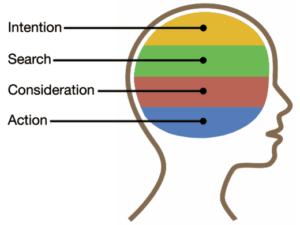I was recently working with a client and struggling with a profoundly low conversion rate coming from search ads. The keywords we were buying were on target, the ads were performing well, and the landing pages appeared well designed. Then I tried to put myself inside the mind of the searcher. When I did that, I realized that the landing pages we were using were not as well designed as I thought, and our ads were missing the mark. The mistake we had made was to consider keywords, ads and landing pages independently. Sure, the ads were relevant to the keywords, and the landing pages were relevant to the ads, but we hadn’t really been thinking about the searcher’s intent through the process. The action we were expecting searchers to take did not fit the need that had motivated them to search. I spend a lot of time thinking about and optimizing for consumer intent, but after making such a mistake, I decided I needed a model against which to judge search ads and campaigns. Following is the model I put together.

Intention – before a person searches, she has an intent: intent to buy a pair of shoes; intent to learn about zanzibar; intent to determine the health benefits of a Blooming Onion; and so on. Some sort of information need driven by intention motivates her to search. When we start a search marketing campaign for a business, we begin by defining personae we intend to target with the campaign. The personae represent categories of intent. For example, shoe-shopping personae might include fashionistas and pragmatists. Fashionistas want to know what’s hot, pragmatists want a trustworthy vendor with a good return policy. We tend to organize our campaigns around the personae we define.
Search – once the person has translated intent into an information need, e.g. “I want a new pair of shoes” -> “where should I buy a pair of shoes?”, she turns to a search engine. While this step in the process garners a lot of attention among marketers, it is largely procedural in nature. Search listings do not address the searcher’s intent (you can’t wear them, for example), nor do they meet her information need in any real sense. They are merely pointers to information. The searcher quickly scans search results, looking for cues that indicate her need will be met by clicking on a listing. The right cues to include are a natural consequence of the personae we’ve defined. We also have to be mindful that there is a lot of information on a search results page. We can provide the right cues, but if our listing is boring or far down the results, it may never get evaluated.
Consideration – after clicking on a listing, the searcher evaluates the content on the landing page. Does it address her information need? She has criteria, conscious or unconscious, with which she will make a quick decision and either move forward or back up. The important thing here is to make sure that the landing page aligns with her original intent and is easy to digest. Too much information and she is likely to back up and look for a more suitable source. Too little information and her criteria can’t possibly be met.
Action – lastly, as marketers, we want the searcher to take some form of action, whether it be to call a number, watch a video or buy a product. Again, it is not a good idea to overwhelm the searcher with too many options, nor is it a good idea to present too few. Some people may be uncomfortable calling and prefer to communicate via email. Some people may want to read technical specifications before buying a product. The main thing is to decide what actions you want to emphasize, and make them as frictionless as possible.
This model bears a lot of similarity to the classic purchase funnel found in many marketing textbooks. It can be viewed as a specific instance of the funnel, applied to search marketing. I find it helpful, but the main point is that different types of keywords and search phrases belie different kinds of intent. When focusing on one stage of the process independently, it can be easy to lose track of that fact.
Nico Brooks is a data geek who struggles to get his head around marketing problems, but he always enjoys the struggle. Two Octobers is an internet marketing company that provides marketing services and strategic consulting to businesses selling to local markets.




